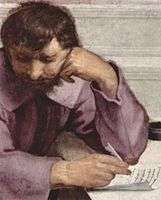Communion of the Apostles (Barocci)
The Communion of the Apostles, or Institution of the Eucharist is a painting of the Last Supper by Federico Barocci located at Santa Maria sopra Minerva in Rome. It was commissioned for the family chapel of Pope Clement VIII Aldobrandini and completed between 1603 and 1608.[1]
| The Communion of the Apostles | |
|---|---|
| Italian: Deposizione | |
 | |
| Artist | Federico Barocci |
| Year | 1608 |
| Medium | Oil on canvas |
| Dimensions | 290 cm × 177 cm (110 in × 70 in) |
| Location | Santa Maria sopra Minerva, Rome |
It was most likely the sight of Barocci's Presentation of the Virgin in the Chiesa Nuova at its unveiling in 1603 that led to the commission of the Communion four months later. On 13 August 1603 the pope communicated with the minister to Francesco Maria II della Rovere, duke of Urbino, Giacomo Sorbolongo, about acquiring an altarpiece from Barocci.[lower-alpha 1] At this time the Cavaliere d'Arpino was the pope's most important artist; the letter goes on to ask that d'Arpino not be told of the commission.[lower-alpha 2][2]


The commission was completed entirely in Urbino and efforts were made to supply Barocci with extensive information about the contextual chapel, which was frescoed by Cherubino Alberti with a Triumph of the Holy Cross.[3] Gian Pietro Bellori wrote that the pope was supplied with preparatory sketches.[4] The pope sought the removal of Satan from the original design,[1] and thereafter asked that it depict a night scene.[5]
Barocci quotes from Raphael's School of Athens by inserting the portrait of Heraclitus, which many believe is a portrait of Michelangelo. Significantly, he depicts Judas Iscariot using Michelangelo's portrait.[1] To an audience familiar with this association, this would have been taken as particularly strong commentary on the status of the Michelangelo.[6] Furthermore, by directly quoting from Raphael, who was Michelangelo's antithesis and favoured by the Clementine church, Barocci, and by implication Pope Clement VIII, inserted a comment on the relative status of the two artists within the church of the time.[1]
Barocci asked 1,500 scudi for the altarpiece. The fee undoubtedly was influenced by the number of figures. At the same point in his career (1604), he had accepted 300 scudi for a much simpler Crucifixion (Museo del Prado, Madrid).[7]
Notes
- Stasera uerso il tardi il Papa mi ha fatto chiamare, et quando sono stato dent'ro, mi ha detto ridendo, che se bene era cosa leggieri, per la quale mi hauea fatto dimandare, era per'o un suo gusto et seguit'o, come fa fabricare una Capella qui nella Minerua in memoria de' suoi, Padre, Madre et fratelli, et desiderando, che nell'altare di essa ci fosse il quadro fatto da uallente huomo, se bene qui ce ne sono et in particulare ha Iseppino, non dimeno si sodisfarebbe assai hauerlo di mano del Baroccio.
- desidera non si sappia da altri tal pratica, massime per rispetto d'Iseppino
References
- Verstegen, Ian (Spring 2003). "The apostasy of Michelangelo in a painting by Federico Barocci". Notes in the History of Art. 22 (3): 27–34. JSTOR 23206723.
- Verstegen, Ian (Spring 2003). "Federico Barocci, Federico Borromeo, and the Oratorian Orbit". Renaissance Quarterly. 56 (1): 56–87. doi:10.2307/1262258. JSTOR 1262258.
- Emiliani, Andrea (1985). Federico Barocci (Urbino 1535-1612). Bologna: Nuova Alfa Editoriale. pp. 376–385.
- Bellori, Giovanni Pietro; Wohl, Alice Sedgwick; Wohl, Hellmut; Montanari, Tomaso (2005). Giovan Pietro Bellori: The Lives of the Modern Painters, Sculptors and Architects: A New Translation and Critical Edition. Cambridge University Press. ISBN 9780521781879. Retrieved 13 July 2014.
- McGrath, Thomas (June 2000). "Color and the Exchange of Ideas between Patron and Artist in Renaissance Italy". The Art Bulletin. 82 (2): 298–308. doi:10.2307/3051378. JSTOR 3051378.
- Hansen, Morten Steen (2013). In Michelangelo's Mirror. Penn State Press. pp. 148–149. ISBN 9780271056401. Retrieved 24 August 2014.
- Spear, Richard (June 2003). "Scrambling for Scudi: Notes on Painters' Earnings in Early Baroque Rome". The Art Bulletin. 85 (2): 310–320. doi:10.2307/3177346. JSTOR 3177346.